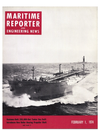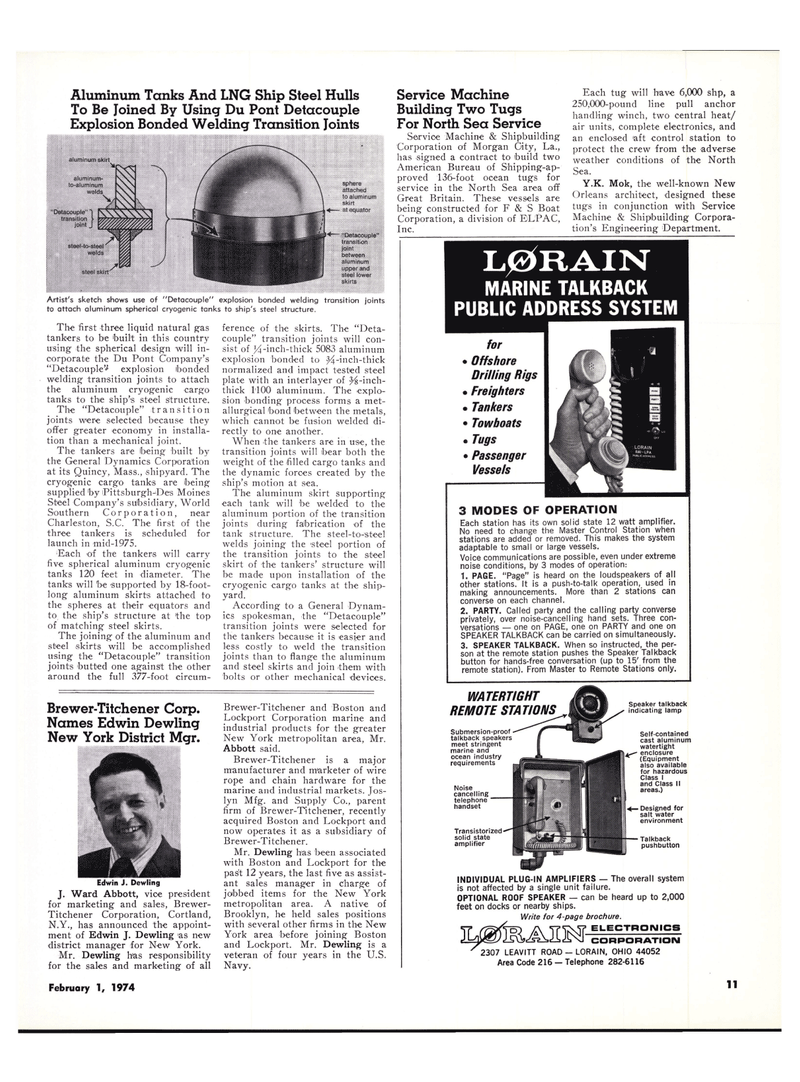
Page 8: of Maritime Reporter Magazine (February 1974)
Read this page in Pdf, Flash or Html5 edition of February 1974 Maritime Reporter Magazine
The first three liquid natural gas tankers to be 'built in this country using the spherical design will in- corporate the Du Pont Company's "Detacouple^ explosion bonded welding transition joints to attach the aluminum cryogenic cargo tanks to the ship's steel structure.
The "Detacouple" transition joints were selected because they offer greater economy in installa- tion than a mechanical joint.
The tankers are Ibeing built by the General Dynamics Corporation at its Quincy, Mass., shipyard. The cryogenic cargo tanks are being supplied by iPittsburgh-Des Moines
Steel Company's subsidiary, World
Southern Corporation, near
Charleston, S.C. The first of the three tankers is scheduled for launch in mid-1975.
Each of the tankers will carry five spherical aluminum cryogenic tanks 120 feet in diameter. The tanks will be supported by 18-foot- long aluminum skirts attached to the spheres at their equators and to the ship's structure at the top of matching steel skirts.
The joining of the aluminum and steel skirts will be accomplished using the "Detacouple" transition joints butted one against the other around the full 377-foot circum-
Brewer-Titchener Corp.
Names Edwin Dewling
New York District Mgr.
Edwin J. Dewling
J. Ward Abbott, vice president for marketing and sales, Brewer-
Titchener Corporation, Cortland,
N.Y., has announced the appoint- ment of Edwin J. Dewling as new district manager for New York.
Mr. Dewling has responsibility for the sales and marketing of all ference of the skirts. The "Deta- couple" transition joints will con- sist of -inch-thick 5083 aluminum explosion bonded to %-inch-thick normalized and impact tested steel plate with an interiayer of ^-inch- thick 1100 aluminum. The explo- sion bonding process forms a met- allurgical bond between the metals, which cannot be fusion welded di- rectly to one another.
When the tankers are in use, the transition joints will bear both the weight of the filled cargo tanks and the dynamic forces created by the ship's motion at sea.
The aluminum skirt supporting each tank will be welded to the aluminum portion of the transition joints during fabrication of the tank structure. The steel-to-steel welds joining the steel portion of the transition joints to the steel skirt of the tankers' structure will be made upon installation of the cryogenic cargo tanks at the ship- yard.
According to a General Dynam- ics spokesman, the "Detacouple" transition joints were selected for the tankers because it is easier and less costly to weld the transition joints than to flange the aluminum and steel skirts and join them with bolts or other mechanical devices.
Brewer-Titchener and Boston and
Lockport Corporation marine and industrial products for the greater
New York metropolitan area, Mr.
Abbott said.
Brewer-Titchener is a major manufacturer and marketer of wire rope and chain hardware for the marine and industrial markets. Jos- lyn Mfg. and Supply Co., parent firm of Brewer-Titchener, recently acquired Boston and Lockport and now operates it as a subsidiary of
Brewer-Titchener.
Mr. Dewling has been associated with Boston and Lockport for the pas't 12 years, the last five as assist- ant sales manager in charge of jobbed items for the New York metropolitan area. A native of
Brooklyn, he held sales positions with several other firms in the New
York area before joining Boston and Lockport. Mr. Dewling is a veteran of four years in the U.S.
Navy.
Service Machine
Building Two Tugs
For North Sea Service
Service Machine & Shipbuilding
Corporation of Morgan City, La., has signed a contract to build two
American Bureau of Shipping-ap- proved 136-foot ocean tugs for service in the North Sea area off
Great Britain. These vessels are being constructed for F & S Boat
Corporation, a division of ELPAC,
Inc.
Each tug will have 6,000 shp, a 250.000-pound line pull anchor handling winch, two central heat/ air units, complete electronics, and an enclosed aft control station to protect the crew from the adverse weather conditions of the North
Sea.
Y.K. Mok, the well-known New
Orleans architect, designed these tugs in conjunction with Service
Machine & Shipbuilding Corpora- tion's Engineering Department. 3 MODES OF OPERATION
Each station has its own solid state 12 watt amplifier.
No need to change the Master Control Station when stations are added or removed. This makes the system adaptable to small or large vessels.
Voice communications are possible, even under extreme noise conditions, by 3 modes of operation: 1. PAGE. "Page" is heard on the loudspeakers of all other stations. It is a push-to-talk operation, used in making announcements. More than 2 stations can converse on each channel. 2. PARTY. Called party and the calling party converse privately, over noise-cancelling hand sets. Three con- versations — one on PAGE, one on PARTY and one on
SPEAKER TALKBACK can be carried on simultaneously. 3. SPEAKER TALKBACK. When so instructed, the per- son at the remote station pushes the Speaker Talkback button for hands-free conversation (up to 15' from the remote station). From Master to Remote Stations only.
WATERTIGHT
REMOTE STATIONS
Submersion-proof talkback speakers meet stringent marine and ocean industry requirements
Noise cancelling telephone handset
Transistorized solid state amplifier
Speaker talkback indicating lamp
Self-contained cast aluminum watertight enclosure (Equipment also available for hazardous
Class I and Class II areas.)
Designed for salt water environment
Talkback pushbutton
INDIVIDUAL PLUG-IN AMPLIFIERS — The overall system is not affected by a single unit failure.
OPTIONAL ROOF SPEAKER — can be heard up to 2,000 feet on docks or nearby ships.
Write for 4-page brochure.
ELECTRONICS
CORPORATION 2307 LEAVITT ROAD - LORAIN, OHIO 44052
Area Code 216 — Telephone 282-6116
Aluminum Tanks And LNG Ship Steel Hulls
To Be Joined By Using Du Pont Detacouple
Explosion Bonded Welding Transition Joints aluminum skirt alumiraim-to-alumingm welds
Artist's sketch shows use of "Detacouple" explosion bonded welding transition joints to attach aluminum spherical cryogenic tanks to ship's steel structure.
L0RAIN
MARINE TALKBACK
PUBLIC ADDRESS SYSTEM for • Offshore
Drilling Rigs • Freighters • Tankers • Towboats • Tugs • Passenger
February 1, 1974 11

 7
7

 9
9
